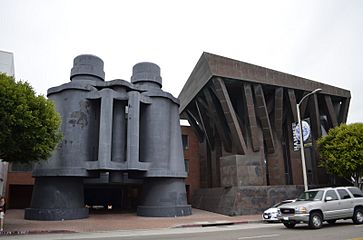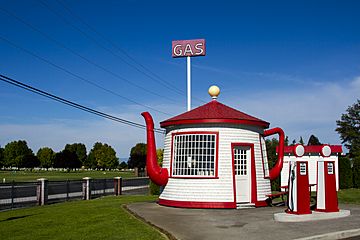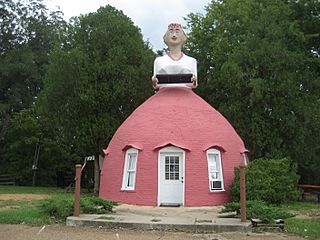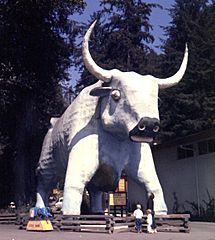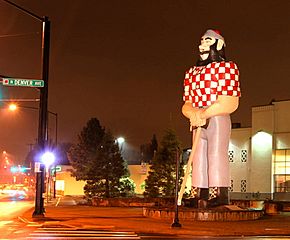Novelty architecture facts for kids


Novelty architecture is a fun and unique type of building design. It's when buildings are made into unusual shapes, often to look like everyday objects, animals, or even famous landmarks. These buildings are usually designed to grab attention, like for advertising, or to become famous landmarks themselves.
Unlike "architectural follies," which are just decorative buildings you can't really use, novelty architecture buildings are fully usable. They just happen to be shaped in a very creative way!
Contents
What is Novelty Architecture?
Even though some older examples exist, like the Elephant of the Bastille in Paris (which was planned but never built), this style became really popular in the United States. It spread around the world as more people started traveling by car in the 1930s.
A great example is the Statue of Liberty in New York. It's a huge sculpture and monument that you can go inside. Like many novelty buildings, it became a huge tourist attraction.
Building these unique structures near roads was a clever way to get drivers to stop at a diner or coffee shop. Imagine seeing a giant coffee pot and knowing there's coffee inside! Many roadside coffee shops were built to look like huge coffee pots, hot dog stands looked like giant hot dogs, and fruit stands were shaped like big oranges.
Some famous examples include:
- The Tail o' the Pup, a hot dog stand shaped like a hot dog.
- The Brown Derby, a restaurant shaped like a derby hat.
- The Big Apple Restaurant, a 10.7 metres (35 ft) tall apple.
- The Big Duck, a poultry store shaped like a duck (it's not a store anymore, but still a landmark).
- The Gibeau Orange Julep in Montreal, a 12-meter tall orange sphere that's still open today!
Novelty buildings can look like almost anything: characters, animals, people, or even household items. Lucy the Elephant and The Longaberger Company's main office (shaped like a giant picnic basket) are perfect examples. Sometimes, these buildings look like cartoons or caricatures. These giant objects often become attractions all by themselves.
Many novelty buildings are designed to attract customers by looking like the products they sell. Others, especially in places like Las Vegas and Macau, are copies of famous landmarks from around the world.
Types of Novelty Buildings
Buildings Shaped Like Objects or Animals
These buildings are designed to look like a giant object or creature. They are often related to what's sold inside. This style was very popular in the United States, but you can find them all over the world.
Some examples include:
- The High-Heel Wedding Church in Taiwan.
- The Mr. Toilet House in South Korea.
- The Museum of Tea Culture in China.
- The National Fisheries Development Board building in India, shaped like a fish.
- The Elephant Building in Thailand.
- The Wolfartsweier Cat Kindergarten and the BMW Headquarters in Germany.
Buildings That Look Like Famous Landmarks
Novelty architecture can also involve making buildings that look like famous landmarks. You can find these in places like China, Georgia, Japan, and the United States.
These replica buildings are often used in casinos, hotels, shopping centers, or amusement parks like Disneyland. Their playful designs are meant to make these places more appealing. Sometimes, like with Carhenge, a structure is a creative take on a well-known building.
For example:
- A shopping center in Kansas City, Missouri, has a half-sized copy of La Giralda from Sevilla, Spain.
- In Las Vegas, casinos are designed to look like famous places:
- The Luxor Hotel is shaped like a pyramid.
- The New York-New York Hotel & Casino looks like the New York City skyline.
- Paris Las Vegas looks like the Paris Opera House and the Louvre museum.
- The Excalibur Hotel and Casino looks like King Arthur's castle.
- In Macau, The Venetian Macao has copies of buildings from Venice, Italy, including St Mark's Campanile.
- In Batumi, Georgia, new buildings include a Sheraton Hotel designed like the Great Lighthouse of Alexandria, the Alphabet Tower (145 metres (476 ft) high) celebrating Georgian writing, and buildings styled after the Leaning Tower of Pisa and the Acropolis.
- In China, the New South China Mall has a 25 metres (82 ft) copy of the Arc de Triomphe and a canal with gondolas like in Venice.
- In Japan, the Huis Ten Bosch theme park has copies of Dutch landmarks.
Water Towers and Storage Tanks
Water towers and large storage tanks are often big parts of a town's skyline. Many of these have been shaped or decorated to look like everyday objects.
You can find water towers shaped like:
- Peaches
- Coffee pots and teapots
- Corn cobs
- Wine bottles and sauce bottles
- Fishing bobbers and strawberries
Some breweries and other businesses have even designed their storage tanks to look like giant cans of beer or other containers.
Giant Sculptures
Another type of novelty architecture involves huge sculptures of ordinary items. These are often found at roadside parks, attractions, or museums in places like Australia, Canada, Japan, New Zealand, the Philippines, and the United States.
These sculptures often represent:
- Local animals (like fish or other wildlife).
- Local plants (like apples or pineapples).
- Well-known local people (like Paul Bunyan).
- Food (like giant candy bars).
- Sports or mechanical equipment (like giant bats, balls, or tires).
- Musical instruments (like guitars).
- Clothing (like giant boots).
- Popular creatures (like dinosaurs).
Sometimes, a giant sculpture is connected to a building and helps explain what the building is about. For example, there's a giant baseball bat outside the Louisville Slugger Museum & Factory.
Other Styles
In the 1950s and 1960s, a style called Googie (or Doo Wop or populuxe) became popular in southern California and Florida. It featured sharp corners, tilted roofs, and starburst designs.
Even well-known companies with famous designs can be seen as novelty architecture. Think of McDonald's original golden arches or the castle-like design of White Castle restaurants.
What Do People Think?
Some people, like photographer and critic John Margolies, really admire novelty architecture. He called the Madonna Inn "an extraordinary architectural monument," built by owners who were creative in their own unique way.
Other experts, like Robert Venturi, Denise Scott Brown, and Steven Izenour, have studied places like the Las Vegas Strip. They noted how modern architecture sometimes tries to be very serious, but these fun, commercial buildings show a different, more playful side of design.
Gallery
Buildings in the United States
-
Lucy the Elephant in Margate City, New Jersey (1881)
-
Coffeepot water tower in Lindstrom, Minnesota (1902)
-
The original Brown Derby in Los Angeles, California (1926)
-
The Big Duck in Flanders, New York (1931)
-
Corn cob water tower in Rochester, Minnesota (1931)
-
Hot Cha Cafe, now Koffee Pot Cafe; Long Beach, California (ca. 1932)
-
A 64-foot-tall (20 m) Nehi Bottle located near Auburn, Alabama, in an area referred to as "The Bottle" (destroyed by fire in 1933)
-
Benewah Milk Bottle in Spokane, Washington (1935)
-
World's Largest Catsup Bottle water tower in Collinsville, Illinois (1949)
-
Wigwam Motel in Holbrook, Arizona (1950)
-
Coney Island Hot Dog Stand in Bailey, Colorado (1966)
-
At Cabazon Dinosaurs in Cabazon, California; this dinosaur's belly holds a souvenir shop
-
The Big Chicken in Marietta, Georgia
-
Randy's Donuts (1953) in Inglewood, California
-
Dog Bark Park, Cottonwood, Idaho
-
The Chiat/Day Building (1991), by Frank Gehry, in Venice, California.
-
Teapot Dome Service Station in Zillah, Washington.
Buildings around the world
-
Gibeau Orange Julep, Montreal, Quebec, Canada
-
Large barrel-shaped bistro and bar in Okinawa City, Japan
-
The Pysanka or Painted Easter Egg Museum in Kolomyia, Ukraine
-
The High-Heel Wedding Church in Taiwan
-
Wolfartsweier Cat Kindergarten in Germany
-
Office building of the National Fisheries Development Board (NFDB) in Hyderabad, India
-
A Twistee Treat restaurant in Minden, Ontario
-
The Big Merino in Goulburn, New South Wales, Australia.
-
The Tuborg Bottle in Copenhagen.
Statues
-
Dinosaur Park sculpture of a Tyrannosaurus rex in Rapid City, South Dakota (1936)
-
Babe the Blue Ox at Trees of Mystery in Klamath, California (1949)
-
Golden Driller statue in Tulsa, Oklahoma (1953)
-
Paul Bunyan statue in Portland, Oregon (1959)
-
Johnny Kaw statue in Manhattan, Kansas (1966)
-
Apatosaurus statue at North Carolina Museum of Life and Science in Durham, North Carolina (1967)
-
Paul Bunyan statue in Akeley, Minnesota
-
Harvey statue at Harvey Marine in Aloha, Oregon
-
World's Largest Dinosaur in Drumheller, Alberta, Canada (2000)
-
World's Largest Muskellunge in Hayward, Wisconsin at the National Freshwater Fishing Hall of Fame.
-
Big fruit outside Cromwell, Central Otago, New Zealand
-
Kiwi fruit in Te Puke, New Zealand
-
Giant Canadian two-dollar coin Monument, Campbellford ,Ontario
-
Paul Bunyan and Babe the Blue Ox statues at Trees of Mystery
See also
- Australia's big things
- Ice hotels, temporary hotels made of ice and snow
- John Margolies, a photographer who took pictures of roadside attractions
- List of world's largest roadside attractions
- Muffler Men, huge fiberglass sculptures used to promote businesses
- New Zealand's big things
























